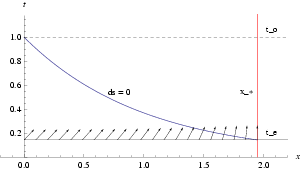I’m giving a talk here in Paris tomorrow on the question of how to interpret the cosmological redshift. The talk is based on the paper David Hogg and I wrote last year. I said a bit about the argument of the paper in a previous post. I’ll quickly recap the big idea, but then I want to comment on some followups to our paper: a blog post by Sean Carroll (from way back when we first posted our paper) and a recent paper by MichaÅ‚ Chodorowski.
First the background. The most important fact in cosmology is that the light from distant galaxies is redshifted. This fact is the observational basis for the idea of the expanding Universe. Most of the time, when you see a redshift, it’s a Doppler shift — that is, it’s caused by the fact that the observed object is moving away from you. In the cosmological context, though, people often say that the observed redshift has a different explanation: they say that the galaxies aren’t “really” moving, but rather that space itself is expanding, which causes the light to be stretched out in wavelength. Hogg and I argue for the rehabilitation of the idea that the galaxies are moving and the observed redshift can be regarded as a Doppler shift.
The main thing to realize about all this is that we’re talking purely about a question of interpretation: everybody (at least, everybody sane) agrees on the physics — the argument is only about what words to wrap around the physics. Sean Carroll expressed this well in his blog post:
These are not arguments about the theory €” everyone agrees on what GR predicts for observables in cosmology. These are only arguments about an analogy, i.e. the translation into English words.
…
The point is, arguments about analogies (and, by extension, the proper words in which to translate some well-accepted scientific phenomenon) are not "right" or "wrong." The analogies are simply "useful" or "useless," "helpful" or "misleading." And which of these categories they fall into may depend on the context.
This is 100% right. We argue in our paper that the expanding-space picture in cosmology (particularly the metaphor of a stretching rubber sheet or balloon) is misleading, in that it leads people to some incorrect intuitions about the nature of space, and we try to suggest different a way of looking at things. But our way has its flaws too: all of these verbal descriptions are at best incomplete at capturing the whole picture. We try to argue forcefully in favor of our way of looking at things, but the truth is that I’d be happies if people are exposed to several different ways, not just ours.
Here’s something else Sean says:
On the other hand, there is another pernicious mistake that people tend to make: the tendency, quite understandable in Newtonian mechanics, to talk about the relative speed between two far-away objects. Subtracting vectors at distinct points, if you like. In general relativity, you just can't do that. And realizing that you just can't do that helps avoid confusions along the lines of "Don't sufficiently distant galaxies travel faster than light?" And reifying a distinction between the Doppler shift and the cosmological redshift is a good first step toward appreciating that you can't compare the velocities of two objects that are far away from each other.
The beginning of this is exactly right: A central idea of general relativity is that you can’t compare vectors at distant points, which means that there’s no well-defined way to talk about the velocity of A relative to B, when A and B are far apart. But I think he goes completely off the rails in the last sentence.
Sean seems to think that the expanding-rubber-sheet metaphor helps to convey the idea that you can’t talk about velocities of distant objects, but I think it does precisely the opposite. The rubber-sheet picture virtually demands that you think of things that are just sitting still on the rubber sheet as being “really” at rest. In its most extreme form (found in a lot of textbooks and pop-science books), the rubber-sheet metaphor says that distant galaxies are not moving with respect to us — that is, not that their velocities with respect to us are undefined, but that they’re zero!
In effect, the rubber sheet acts in people’s minds like a sort of aether, i.e., a preferred frame to use in defining all motions. This is precisely the opposite of how you want to understand space in relativity.
Anyway, that post of Sean’s is ancient history (more than a year old). Here’s something much more recent: the paper by Chodorowski called “The kinematic component of the cosmological redshift.” Chodorowski adopts a similar philosophy to us in some ways: he, like us, observes that if you want to talk about the velocity of a distant galaxy, you need to adopt a prescription for “carrying” its velocity vector over to us. But while we argue that the most natural prescription is to carry the vector along the light path, he says that it’s more natural to carry the vector from one location to the other at a fixed moment in time. Figure 1 of his paper illustrates this:
I tend to disagree with his assessment of which path is more natural. The reason is that the comparison we want to make is between the galaxy’s velocity at the time of emission and our velocity now. That is, the two vectors we want to compare live at the lower right and upper left of his diagram. If you follow Chodorowski’s path from right to left across the bottom, you then have to make a right turn and head up the t axis. (He also considers the alternative where you go straight up first and then across.) My preferred path is along the solid curve in the figure.
But the truth is that these “naturalness” questions are always matters of taste. Chodorowski’s point of view is a very reasonable and sensible one, and this is a very nice paper.
Chodorowski’s two options correspond in effect to figuring out (a) the relative velocity of the galaxy and us back then (at the time of emission), and (b) the relative velocity of the galaxy and us now. Hogg and I calculate something that can best be described as (c) the velocity of the galaxy then relative to us now. In my dream world, people who want to understand the nature of the redshift would examine what happens when you do all three possibilities, and why they’re different.

